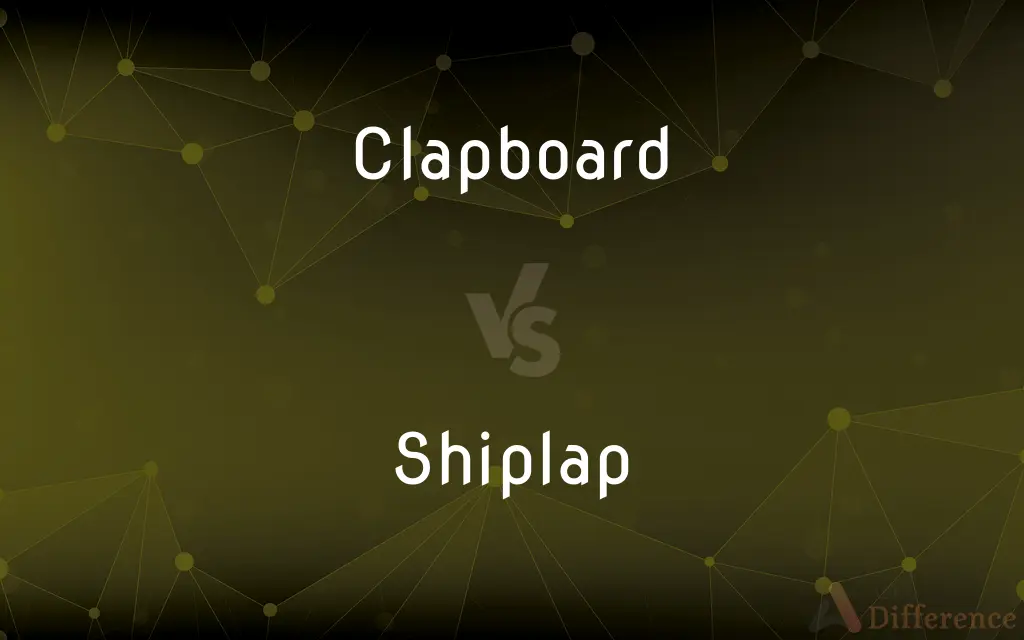Clapboard vs. Shiplap — What's the Difference?
Edited by Tayyaba Rehman — By Maham Liaqat — Updated on April 23, 2024
Clapboard and shiplap are both types of wooden siding but differ in their design: clapboard has overlapping planks with a wedge shape, while shiplap has a rabbet joint for a flush installation.

Difference Between Clapboard and Shiplap
Table of Contents
ADVERTISEMENT
Key Differences
Clapboard siding features horizontally overlapping planks that are thicker at the bottom than at the top, creating a wedge-like profile. This design helps shed water effectively, making clapboard popular in areas with heavy rainfall. On the other hand, shiplap consists of wooden boards cut with a rabbet on opposite sides of each edge to fit together snugly, creating a tight seal that gives a smooth, uniform appearance.
Clapboard's overlapping design exposes more of the wood's face to the elements, potentially requiring more maintenance such as painting or staining to prevent weather damage. Whereas, shiplap fits together in a way that protects the joints from water ingress, often resulting in a longer-lasting finish under proper maintenance.
In terms of aesthetic, clapboard provides a traditional look that has been associated with American colonial architecture. Its shadow lines and textured appearance offer a classic exterior façade. Conversely, shiplap has gained popularity in modern farmhouse and contemporary designs due to its clean lines and seamless appearance, which adapt well to both interior and exterior applications.
Installation of clapboard can be more labor-intensive due to the need to ensure each plank overlaps correctly to prevent water penetration. Shiplap, with its interlocking design, can be quicker to install, often making it a preferred choice for DIY projects or faster-paced construction environments.
Despite their differences, both clapboard and shiplap offer durable siding options that can be made from a variety of wood types, including cedar and pine, providing versatility in style and design suited to different architectural tastes and climate conditions.
ADVERTISEMENT
Comparison Chart
Design
Wedge-shaped, overlapping planks
Flat boards with rabbet joints that fit together
Water Shedding
Effective due to overlapping
Good, with tight seals at joints
Maintenance
May require more frequent due to exposure
Less exposed, potentially lower maintenance
Aesthetic Appeal
Traditional, textured look
Modern, smooth look
Installation
Labor-intensive, careful overlapping required
Easier, faster due to interlocking design
Compare with Definitions
Clapboard
A type of siding made from wedge-shaped boards that overlap each other.
The old cottage was covered in weathered clapboard, giving it a rustic charm.
Shiplap
Also used for ceilings and feature walls due to its versatility.
The bedroom’s ceiling was finished with white-painted shiplap, brightening the space.
Clapboard
Offers a classic and textured visual appeal.
The new house features a clapboard exterior that complements its traditional design.
Shiplap
Popular in interior design, particularly in farmhouse style.
They installed shiplap in the living room to enhance the farmhouse aesthetic of their home.
Clapboard
Commonly made from wood like cedar due to its resistance to rot.
Cedar clapboard is favored for its durability and natural resistance to weather.
Shiplap
Wooden siding characterized by rabbet joints on each edge.
The shiplap walls added a modern yet cozy feel to the renovated kitchen.
Clapboard
Traditionally used for exterior wall covering.
Clapboard has been a popular choice in New England homes for centuries.
Shiplap
Known for its tight seal and smooth finish.
Shiplap is often chosen for its sleek, uniform appearance that fits well in contemporary interiors.
Clapboard
Requires periodic maintenance such as painting.
They decided to repaint the clapboard to restore its original appearance.
Shiplap
Can be painted or left natural depending on the desired look.
The shiplap was left natural to highlight the beauty of the wood in the sunroom.
Clapboard
A long, thin, flat piece of wood with edges horizontally overlapping in series, used to cover the outer walls of buildings
Neat clapboard houses
Shiplap
Shiplap is a type of wooden board used commonly as exterior siding in the construction of residences, barns, sheds, and outbuildings.
Clapboard
A long narrow board with one edge thicker than the other, overlapped horizontally to cover the outer walls of frame structures. Also called weatherboard.
Shiplap
Fit (boards) together so that each overlaps the one below
I shiplapped the boards and then glued and screwed them to the braces
Clapboard
To cover with clapboards.
Shiplap
Boards which have been shiplapped, typically used for cladding
Shingles rest on roofing paper laid on shiplap
Clapboard
A narrow board, usually thicker at one edge than the other, used as siding for houses and similar structures of frame construction.
Shiplap
Wooden siding rabbeted so that the edge of one board overlaps the one next to it in a flush joint.
Clapboard
(uncountable) Such boards, arranged horizontally and overlapping with thick edge down, collectively, as siding.
Shiplap
A type of wooden board that has rabbets to allow them to be overlapped.
Clapboard
An oak board of a size used for barrel staves.
Shiplap
To overlap boards by this means.
Clapboard
(film) A clapper board; a device used in film production, having hinged boards that are brought together with a clap, used to synchronize picture and sound at the start of each take of a motion picture or other video production.
Clapboard
To cover with clapboards.
To clapboard the sides of a house
Clapboard
A narrow board, thicker at one edge than at the other; - used for weatherboarding the outside of houses.
Clapboard
A stave for a cask.
Clapboard
To cover with clapboards; as, to clapboard the sides of a house.
Clapboard
A long thin board with one edge thicker than the other; used as siding by lapping one board over the board below
Clapboard
Cover with clapboards
Common Curiosities
What is shiplap?
Shiplap is a type of wooden siding with boards that fit together via rabbet joints, known for a tight seal and smooth appearance.
Is clapboard more expensive than shiplap?
The cost can vary depending on the wood type and availability, but clapboard installation might be more labor-intensive, potentially making it more expensive.
Can shiplap be used outside?
Yes, shiplap can be used for exterior siding, although it is more commonly seen in interior applications.
What is clapboard siding?
Clapboard siding consists of long, wedge-shaped wood planks overlapped horizontally for exterior wall covering.
How often should clapboard and shiplap be maintained?
Maintenance frequency depends on climate and exposure but generally, clapboard might require more frequent upkeep due to its exposure to the elements.
Can I install shiplap myself?
Shiplap's simpler interlocking design makes it a popular choice for DIY projects, as it is generally easier to install than clapboard.
Are there synthetic alternatives to wooden clapboard and shiplap?
Yes, both types of siding are available in vinyl and other synthetic materials, which can offer different maintenance benefits and costs.
Which is more durable, clapboard or shiplap?
Both can be durable, but shiplap's tighter sealing might offer better protection against moisture when properly maintained.
What are the stylistic differences between clapboard and shiplap?
Clapboard offers a textured, traditional look, while shiplap provides a smoother, more contemporary appearance.
Which siding is better for a wet climate?
Clapboard, with its overlapping design, is typically better suited for wet climates as it is designed to shed water effectively.
Does shiplap provide good insulation?
Shiplap alone does not provide significant insulation but can be part of an effective wall assembly when combined with proper insulation materials.
What tools are needed to install clapboard siding?
Typical tools include a circular saw, hammer, nails, and a level to ensure proper alignment and overlap.
Is clapboard considered outdated?
Not necessarily; while it is traditional, many homeowners value the classic look it provides.
How can I tell if my home has real wood clapboard or a synthetic version?
Check the material's texture, weight, and temperature responsiveness; real wood typically feels warmer and less hollow than synthetic versions.
What type of paint is best for shiplap and clapboard?
Exterior-grade paint with mold and mildew resistance is best, especially for outdoor applications.
Share Your Discovery

Previous Comparison
Shiva vs. Siva
Next Comparison
Quintillion vs. QuadrillionAuthor Spotlight
Written by
Maham LiaqatEdited by
Tayyaba RehmanTayyaba Rehman is a distinguished writer, currently serving as a primary contributor to askdifference.com. As a researcher in semantics and etymology, Tayyaba's passion for the complexity of languages and their distinctions has found a perfect home on the platform. Tayyaba delves into the intricacies of language, distinguishing between commonly confused words and phrases, thereby providing clarity for readers worldwide.
















































